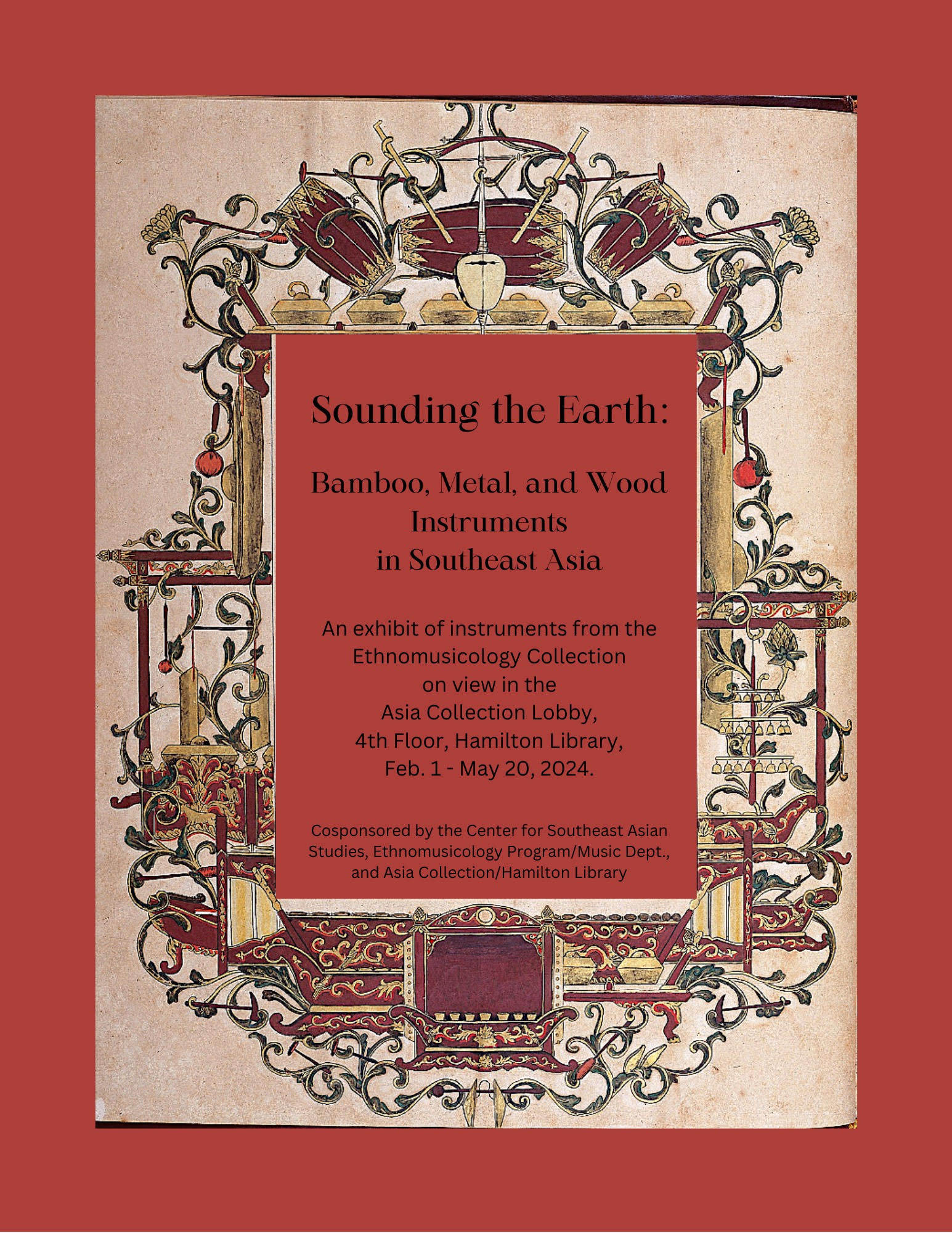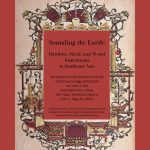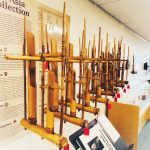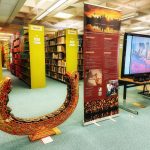Sounding the Earth: Bamboo, Metal & Wood Instruments in Southeast Asia

February 1, 2024-May 20, 2024
Location: Asia Collection
The Center for Southeast Asian Studies, the Ethnomusicology Program in the Music Department, and the Hamilton Library Asia Collection present an exhibit entitled, “Sounding the Earth: Bamboo, Metal, and Wood Instruments of Southeast Asia” on view in Hamilton Library’s 4th Floor Asia Collection from February 1 – May 20, 2024. The exhibit is open to the public during building hours.
Southeast Asia is the nexus between Indian and Pacific Oceans and continental Africa, Asia, and the Pacific Islands. For more than 70-50,000 years, people have migrated to, through, and settled in the region as a result of climate change, conflicts, and trade. Cultural traditions and technologies of different periods in history were carried with people as they migrated within the region. Intimately connected to the environment through the use of bamboo, metal, and wood, Southeast Asian artistic traditions continue sounding the earth.
The region is geographically situated between the Tropics of Cancer and Capricorn. As a result, tropical forests with sustainable supplies of bamboo and hardwood are available to craft instruments used by diverse cultures. The region is rich in basin-related ore deposits that are needed for metallurgy and forging instruments such as various types of gongs. The unique gongs of Southeast Asia have earned the region the moniker, “Gong Cultures.”
This exhibit features select bamboo, metal, and wood instruments from Southeast Asia in the University of Hawaiʻi Ethnomusicology Instrument Collection. The Ethnomusicology Program in the Music Department has a long-standing reputation for excellence in the study of world music, especially the musics of Asian and Pacific cultures.
The Instrument Collection was started by Barbara B. Smith in 1970 and now exceeds more than 2,500 musical instruments from around the world with a particular concentration of instruments from Asia and the Pacific.
The instruments in the Collection are categorized into two subcollections – teaching and research. There are one-of-a-kind instruments collected by Ethnomusicology faculty that are used examples in Ethnomusicology courses (research collection). The teaching collection is comprised of instrument sets that have been donated or purchased for the Ethnomusicology Program for applied music instruction which reflects the philosophy at the heart of Ethnomusicology at UH Mānoa.
The teaching collection has instrument sets from Southeast Asia that include the UH Javanese Gamelan, Kyai Gandrung, the last complete court gamelan to leave Yogyakarta in 1970; a Balinese Gamelan gifted by the Governor of Bali, Indonesia; a Myanmar/Thai classical set of court instruments; and, Philippine instruments from the Cordillera region of northern Luzon and the gong cultures of the Mindanao and Sulu south. Select instruments are featured in this exhibit.
This exhibit features select bamboo, metal, and wood traditional instruments from Southeast Asia research collection but the Instrument Collection also has instruments from South and East Asia as well as the Pacific Islands.
Recently, a record $3.5-million gift to the University of Hawaiʻi at Mānoa from the Barbara Barnard Smith Foundation funded the Music Department’s first-ever Endowed Chair in Ethnomusicology. The newly established Professor Barbara Barnard Smith Endowed Chair will revitalize the Ethnomusicology Program and honors the continuing legacy of the late revered UH Mānoa professor, Barbara B. Smith, who died in 2021.
The exhibit is co-sponsored by the Center for Southeast Asian Studies, The Ethnomusicology Program in the Music Department, and Asia Collection in Hamilton Library, and co-curated by Teri Skillman (Assoc. Dir., CSEAS), Ricardo D. Trimillos (Emeritus, Ethnomusicology Program) and Rohayati Paseng (Southeast Asia Librarian).
For more information, contact Teri Skillman (skillman@hawaii.edu) or Dr. Ricardo D. Trimilos (rtrimil@hawaii.edu). To schedule a class visit, please coordinate with Rohayati Paseng (rohayati@hawaii.edu).





